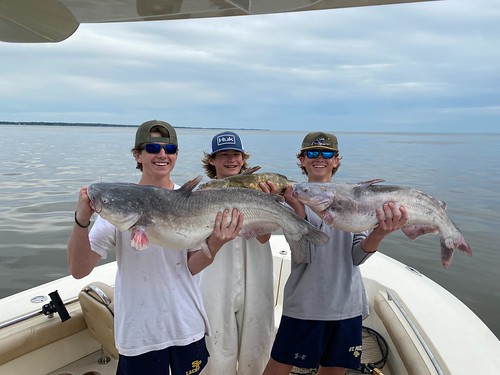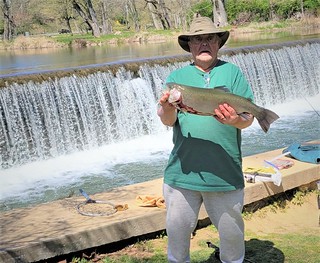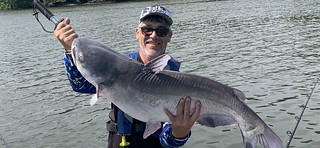Maryland Fishing Report – April 19

This group of high school friends enjoyed some fun fishing together for blue and channel catfish near Pooles Island. Photo by Richard Hoenes
April continues to bring us the many splendors of spring and delightful weather for outdoor activities and fishing. The Maryland Department of Natural Resources trout hatchery program continues generous weekly stockings in many of the state’s waters. As many Chesapeake Bay anglers await the opening of the trophy striped bass season on May 1, others are enjoying fishing for catfish in the Bay and tidal rivers.
Forecast Summary: April 19 – April 25:
Maryland Bay waters continue to warm for gamefish including striped bass, shad, and herring which are spawning or finished spawning in Maryland waters.
Main Bay surface water temperatures have risen to about 60 degrees. The Potomac River at Little Falls and the Susquehanna River at Darlington are reporting warmer water temperatures near 70 degrees. The story continues to be the prolonged dry weather and the resulting low flows and higher than normal Bay salinities. The next chance for rain is this weekend and these increased flows may help bring shad into Maryland’s creeks for waiting anglers.
Expect average clarity for most Maryland portions of the Bay and rivers, however, expect temporarily reduced water clarity from algal blooms on the Gunpowder, Bush, Middle, and Back rivers. To see the latest water clarity conditions, check Eyes on the Bay Satellite Maps.
Expect continued below average flows for most Maryland rivers and streams. There will be above average tidal currents all week as a result of the new moon on April 20.
As always, the best fishing areas could be further refined by intersecting them with underwater points, hard bottom, drop-offs, and large schools of baitfish.
For more detailed and up-to-date fishing conditions in your area of the Bay, be sure to check out Eyes on the Bay’s Click Before You Cast.
The warm weather has done much to improve fishing for hickory shad at Deer and Octoraro creeks and in the Susquehanna River near the Conowingo Dam pool. Increasing numbers of American shad are being caught and released by anglers in the dam pool and Susquehanna.. Most shad catch-and-release anglers are using a tandem rig with a shad dart and a small silver spoon tied in above.
Smallmouth bass are also providing some exciting fishing in the Susquehanna River a short distance below the dam pool. Soft plastic jigs and grubs are popular baits when fishing in the deep eddies and pools. White perch are becoming more common in the lower Susquehanna and are being caught on small jigs and bottom rigs baited with pieces of bloodworm.
Flathead catfish are being caught in the dam pool by anglers using surf fishing spinning outfits and casting into the turbine wash with large pieces of cut bait, with just enough weight to get down to the fish. A little farther down the river, blue and channel catfish can be found in large numbers in the deeper parts of the channel near the railroad bridge and down to Havre de Grace. Many anglers are also jigging with soft plastic along channel edges and having some light tackle jigging action.
The nearby Elk River and other tidal rivers in the upper Bay all have blue and channel catfish. They can also be found in the Bay in many locations. Fresh cut bait of menhaden, gizzard shad, chicken liver, chicken breast meat, or wild table shrimp all work well. The Chester River contains a large population of blue catfish.
White perch are found in the middle sections of most of the region’s tidal rivers. The channels are the highway they are using as they head down to their summertime haunts near the mouths of the rivers. Bottom rigs baited with pieces of bloodworm are the most popular way to fish for them in these deeper waters.
Chesapeake Bay anglers are patiently waiting for May 1, opening day of the trophy striped bass season, by tuning up gear and putting finishing touches on boats. Others enjoy fishing for catfish, white perch, and hickory shad in the tidal rivers.
A mix of channel and blue catfish can be found in the Bay and all the region’s tidal rivers. The channel catfish are widespread and blue catfish are showing up with increased regularity. The Choptank River holds the highest concentrations of blue catfish, from the Dover Bridge upriver to Denton. Fresh-cut bait of menhaden or gizzard shad is a very popular bait, but chicken liver and breast pieces work. If on a low tide you happen upon some rangia clams, which are common in the brackish water sections of the Choptank River, they make excellent bait when shucked. Blue catfish will routinely eat rangia clams whole.
White perch in the tidal rivers are steadily headed for the lower sections where they will reside until the fall. Most anglers are using bottom rigs baited with pieces of bloodworm to reach the white perch as they move along in the deeper waters.
Hickory shad have reached the upper parts of the Choptank River at Red Bridges between Greensboro and Goldsboro. Small shad darts rigged in tandem with small silver spoons are a popular choice for this catch-and-release fishery.
The tidal rivers of the lower Bay are offering plenty of fishing action for blue catfish this week. The tidal Potomac River from the Wilson Bridge south to the Route 301 Bridge holds great numbers of blue catfish, some of which are very large. Anglers are drifting baits into the channels or jigging with soft plastics. Cut bait of menhaden, gizzard shad, chicken liver of breast, wild grocery store shrimp, and a variety of scented baits work well.
The Patuxent River from Benedict to Jug Bay holds large numbers of blue catfish, and the Nanticoke River near Sharpstown also holds a large population. Increasing numbers of blue catfish are beginning to show up in the Wicomico and Pocomoke rivers.
Hickory and American shad are providing fun catch-and-release fishing this week in the upper tidal Potomac at the Fletchers Landing area and Mattawoman Creek. Shad darts rigged in tandem with small silver spoons are the most popular rig to cast with light spinning gear. Small colorful weighted flies are being used by those using fly casting rods.
White perch are being found in the tidal creeks and middle sections of the region’s tidal rivers this week. Most of the perch are deep as they use the channel waters to move down the rivers. Using bottom rigs baited with pieces of bloodworm are one of the best ways to fish for them.
Northern snakeheads are becoming more active as water temperatures warm. Look for them on the sunny side of creeks in shallower waters. Catch them by casting white paddletails rigged in a weedless manner and working the lure through spatterdock fields and near shoreline brush. The tidal creeks of lower Dorchester County, and the Nanticoke, Wicomico, Patuxent, and Potomac rivers all have large populations of northern snakeheads.

Bill McGiffin, 83, enjoys fishing at the spillway at the Devil’s Backbone Park in Washington County. Photo by Mike Gammons
Trout fishing in the put-and-take trout waters is taking center stage for many anglers. The trout hatchery and regional biologists are busy replenishing areas so anglers can continue to enjoy a good fishing experience for those that wish to keep the trout they catch.
There are also wonderful trout fishing opportunities in many of the catch-and-release and gear-specific waters. The upper Gunpowder and western region waters such as the Savage provide world class trout fishing experiences.
The upper Potomac River is running clear this week and water temperatures are about 70 degrees. Smallmouth bass can be found near submerged ledges, eddies, and large boulder fields. Casting topwater lures at dawn can offer some exciting topwater action; as the sun climbs in the sky and the waters warm, grubs, small crankbaits, tubes, and soft plastic craws are good choices. Walleye are holding in some of the deeper pools and eddies. Minnows, jigs, and jerkbaits can be good choices to fish for them.
Largemouth bass are spawning in most areas of Maryland except the far western waters. The females will be found in the shallow spawning areas along with the male largemouth bass, protecting their eggs and fry from marauding bluegill and pumpkinseed sunfish looking for a tasty snack.
Fishing for crappie remains good this week, and they can be found holding near structure in medium depths. Marina docks, fallen treetops, sunken wood, and bridge piers are all good places to look for crappie. A small minnow or marabou jig under a slip bobber are excellent choices for baits.
Along the beaches of Assateague Island, anglers are catching black drum in the surf. Sand fleas have been the most popular bait. At the Ocean City Inlet and Route 50 Bridge area, tautog are being caught on sand fleas fished close to the rocks, bulkheads, and bridge piers. Striped bass are also being caught in the area by working soft plastic jigs close to the bottom. This is mostly a fun catch-and-release fishery.
Flounder are being caught in the back bay channels; those leading away from the inlet have been some of the most productive. Drifting Gulp baits, minnows, or squid is the most common tactic. At the Route 90 Bridge anglers are catching and releasing sub-legal striped bass on soft plastic jigs and paddletails.
At the offshore wreck and reef sites, large tautog continue to entertain anglers. Most anglers can catch a limit of tautog, and some are treated to pulling up a tautog in the double-digit weight category.
“We never get over the fishing fever; it’s a delightful disease and thank the Lord there is no cure.” – From a 1951 brochure of the Creek Chub Bait Co.
Maryland Fishing Report is written and compiled by Keith Lockwood, fisheries biologist with the Maryland Department of Natural Resources.
Click Before You Cast is written by Tidewater Ecosystem Assessment Director Tom Parham.
This report is now available on your Amazon Echo device — just ask Alexa to “open Maryland Fishing Report.”



 1-888-373-7888
1-888-373-7888 233733
233733